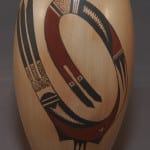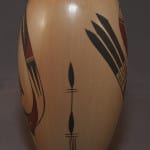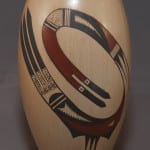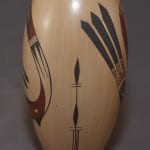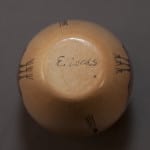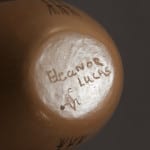Of elegant shape and with an energized design that fits the pot perfectly, this jar is visually accessible and pleases the eye.
The bottom of the jar is only 1.00” wide, tapers up to a width just under 3.00” and then narrows down again to a mouth half that wide. The result is a jar that seems to float off its base. The walls are thin and even. The external polish continues for about 0.5” inside the lip. “Eleanor Lucas” is both etched into the bottom of the jar and signed in ink at the same location.
Eleanor has adopted an Old Lady Nampeyo circular design as the main motif. According to Kramer (1996:187), Nampeyo used this design for only a short period, about 1912-1915. A clear example is shown on page 157 of her book. This same circular design is used on a bowl by Nampeyo published by the Blairs (1999:color fig 2.31A).
On jar 2011-25 the design swirls an observer’s eye up in a counterclockwise direction. Thus both form and design work together to make the pot seem to soar. Seen without a reference point, the jar seems much larger than it actually is. Three pathos feather images emerge from the bottom of each swirl, pulling the eye downward and giving tension to the design. Eleanor is three generations removed from “The Old Lady,” but the quality of her pots and her design strategies are a direct gift from her great grandmother. Separating the two circular designs on 2011-25 are simple linear designs that may also represent patois but here serve to elegantly frame the circular motifs.
Until recently, I had never seen a pot made by Eleanor Lucas. Now the collection contains several of her works. (See the Index of Artists.) Although I surmise that she was not a prolific potter, especially jar 2011-25 indicates that Eleanor (like several sisters) had extraordinary talent as a potter.


